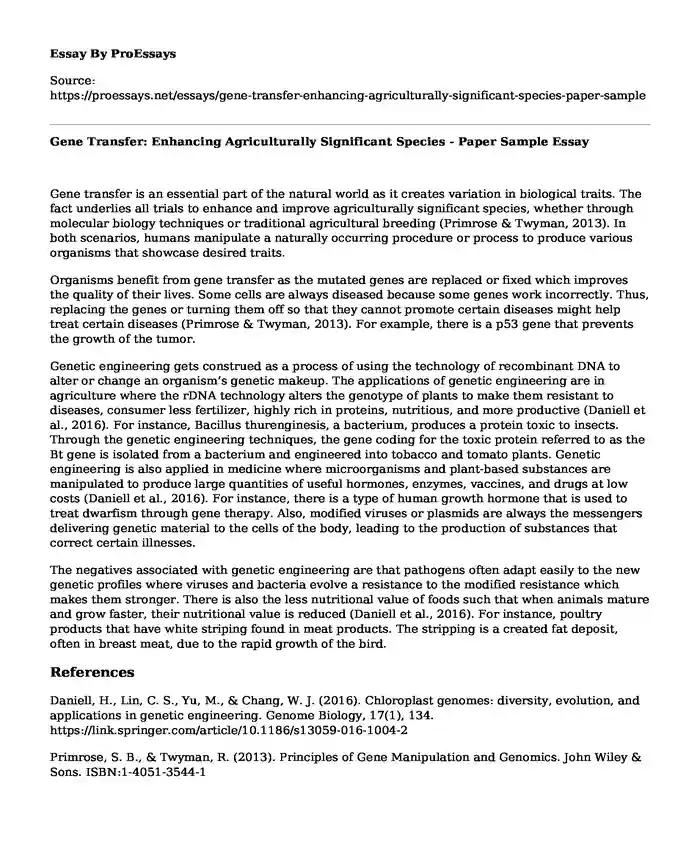Gene transfer is an essential part of the natural world as it creates variation in biological traits. The fact underlies all trials to enhance and improve agriculturally significant species, whether through molecular biology techniques or traditional agricultural breeding (Primrose & Twyman, 2013). In both scenarios, humans manipulate a naturally occurring procedure or process to produce various organisms that showcase desired traits.
Organisms benefit from gene transfer as the mutated genes are replaced or fixed which improves the quality of their lives. Some cells are always diseased because some genes work incorrectly. Thus, replacing the genes or turning them off so that they cannot promote certain diseases might help treat certain diseases (Primrose & Twyman, 2013). For example, there is a p53 gene that prevents the growth of the tumor.
Genetic engineering gets construed as a process of using the technology of recombinant DNA to alter or change an organism’s genetic makeup. The applications of genetic engineering are in agriculture where the rDNA technology alters the genotype of plants to make them resistant to diseases, consumer less fertilizer, highly rich in proteins, nutritious, and more productive (Daniell et al., 2016). For instance, Bacillus thurenginesis, a bacterium, produces a protein toxic to insects. Through the genetic engineering techniques, the gene coding for the toxic protein referred to as the Bt gene is isolated from a bacterium and engineered into tobacco and tomato plants. Genetic engineering is also applied in medicine where microorganisms and plant-based substances are manipulated to produce large quantities of useful hormones, enzymes, vaccines, and drugs at low costs (Daniell et al., 2016). For instance, there is a type of human growth hormone that is used to treat dwarfism through gene therapy. Also, modified viruses or plasmids are always the messengers delivering genetic material to the cells of the body, leading to the production of substances that correct certain illnesses.
The negatives associated with genetic engineering are that pathogens often adapt easily to the new genetic profiles where viruses and bacteria evolve a resistance to the modified resistance which makes them stronger. There is also the less nutritional value of foods such that when animals mature and grow faster, their nutritional value is reduced (Daniell et al., 2016). For instance, poultry products that have white striping found in meat products. The stripping is a created fat deposit, often in breast meat, due to the rapid growth of the bird.
References
Daniell, H., Lin, C. S., Yu, M., & Chang, W. J. (2016). Chloroplast genomes: diversity, evolution, and applications in genetic engineering. Genome Biology, 17(1), 134. https://link.springer.com/article/10.1186/s13059-016-1004-2
Primrose, S. B., & Twyman, R. (2013). Principles of Gene Manipulation and Genomics. John Wiley & Sons. ISBN:1-4051-3544-1
Cite this page
Gene Transfer: Enhancing Agriculturally Significant Species - Paper Sample. (2023, Nov 02). Retrieved from https://proessays.net/essays/gene-transfer-enhancing-agriculturally-significant-species-paper-sample
If you are the original author of this essay and no longer wish to have it published on the ProEssays website, please click below to request its removal:
- The Kidney Role in Homeostasis - Paper Example
- Biological Basis of Genetically Modified Crop Plants Essay
- Human Long Bone, Compact and Spongy Bone Paper Example
- White River Forest: A National Reserve Since the Late Eighties - Research Paper
- Paper Example on Alternate Turns: A Strategy for Moving Efficiently
- Essay Sample on Exploring the Role of the Appendix in the Human Body
- Surviving Off The Land: Necessary Knowledge for Modern Living - Essay Sample







